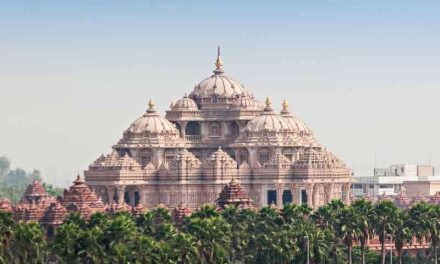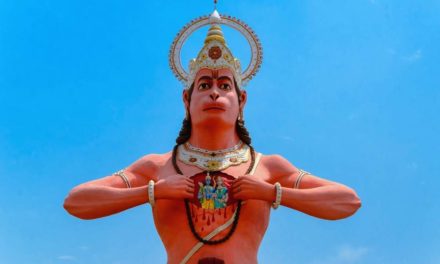The only Hindu god recognized in South India in earlier civilizations was Lord Shiva. Many of the others were tribal deities. In order to incorporate South Indians with North Indians, Hinduism was used as an integration instrument. Religion is an essential part of every worldwide society. This has been used strategically in India for unification. This is the reason why Hindu gods worshipped in North India are different from South India.
Typically individuals from two different societies end up battling each other and creating separate states, hence also separate countries.
In India, amid the plurality of different regions, Hinduism brings the whole society together.
Mostly because of their faith, a Hindu from Tamilnadu and a Hindu from Kashmir feel like part of the same community. The popularity of Ayurveda also got shared in this manner. The Ayurvedic Samhitas play a significant role in the development of organic natural herbal treatments.
South Indians were drawn into Hinduism as they were not initially traditional Hindus.
Even today, Murugan, Maayon, Ayyappan, Female Deities, Ayyanar, Muniyandi, and several other multiple Clan Gods are the popular gods in South India ( Shows their tribal origin).
In South India, the famous Hindu gods in North India do have not much importance. People also give respect to their Gods of the Clans.
In South India, a traditional Hindu would worship both his or her clan god and prominent Hindu gods. Yet clan gods are still given first preference.
In the past as in modern years, this is apparent from the communal protests as well. Through events such as Partition, destruction, and also during recent cries over the beef ban, the South appeared undisturbed (maybe least disturbed).
How was the merger done?
The easiest strategy was to establish a family bond between Hindu gods and tribal gods from South India.
The influential tribal god in South India is Murugan. ( Tamilnadu to be precise). As the younger son of Lord Shiva, Murugan was established.
In northern India, Lord Rama is famous, while in South India, Lord Krishna is famous. Really no one knows what the actual Krishna looks like. But the image of Krishna with a dark skin complexion was created by people. As compared to North Indians, South Indians have a darker skin complexion. Now the portrait of a famous Hindu deity, Krishna, suits the traditional South Indian look.
Another tribal god popular among the Southern communities was Mayon. As a member of the holistic group, Lord Krishna was also made a member of the family. Where then, he replaced Mayon.
This is how Hinduism was tribal worship in the South, and South Indians were eventually drawn into Hinduism. Therefore still now the importance of the Hindu Gods is very limited in the South. But the Hindu Mythology is a complex system of worship that has been handed down by many generations.
Except for Diwali, even Hinduism-centered festivals are not popular in the South. There are various local festivals in every South Indian state. Then Yoga practices got spread among North and South India, which made Hinduism come under a common platform of religious practice. Yogic science has spread across the globe from India during the last century.
It is the dawn of a new civilization in the Vedic Period, and as a result, people from all over the globe have gathered here to establish themselves in the Indus Valley. Similarly, Aryans from the east arrive and successfully intermarry with the indigenous people. The epics like Mahabarata were written by Maha Rishi Veda Vyasa during the period.
A revolution has begun. All brains together now leave tablets similar to this one:
As a community, they then determine which occupations and obligations should be assigned to people, and so the caste system was born.
Then they worshiped nature: they venerated the Earth as their mother, as well as the Sun, Fire, Rain, and Water, all of which sustained them. They named everything and each item had a God who, when appeased, would grant their requests and shower them with affection.
They gradually and methodically established an exact grammatical language. To be sure, the civilization has expanded and today encompasses the majority of North India. Hindu Gods like Hanuman from the Ramayana are worshipped widely in North India.
They began exploring the area and discovered that some mountains and plains were unreachable owing to the severe cold. Thus, people gave these mountains names and erected their Hindu Gods upon them, believing that scaling these mountains or surrounding regions required a great deal of their energy and faith in their Hindu Gods.
As a result, people created literature to please the Hindu Gods. Now, during the investigation, it was discovered that there was a vast surface area remaining to be covered and that the region to the south was entirely covered in water.
Thus, they called this section of land Jambudweepa and constructed temples and places of devotion in different locations of inexplicable magnetism. Thus, Hindu temples sprang up across the nation, and when the Dravidians saw the advantages of mingling with the Aryans, they conformed to the Aryan way of life. Temple worship was the primary mode of faith among the Aryans and Dravidians.
Are the South and North Indian foods different?
The usage of meat and dairy products is more prevalent in northern India, while vegetables and seafood are more prevalent in the southern region. It is well known that both Northern and Southern Indian cuisines make extensive use of curry and other very spicy foods. Southern India, on the other hand, is said to be the spicier of the two regions.
The usage of lentils and spices, as well as green chilies and fresh coconut, is well-known in South Indian cuisine, which is dominated by indigenous vegetables and fruits. Given that rice is the main meal in South India, most of the dishes are made with the intention of being served with rice.
The Rig Veda
The Rig Veda speaks on themes such as morality and appropriate societal behavior, among other things. It deals with major concerns of the day, such as gambling and the proper procedures to ensure good governance in the country. During the Vedic and post-Vedic periods, it served as a religious source as well as a moral guide for the people.
Rig Veda along with the Upanishads gives the Vedic View of the universe. The Rig Veda plays an important part in the unity of all the states of India. Ancient Mantras like the Gayathri Mantra played an important part in India’s Spiritual development. There are other Philosophies like the Darshana Samkhya which deals with the number of realities that exist and the Bramha Sutras which deals with Self Awareness.
The Concept of the AUM in North and South India
The concept and understanding of the Aum for both the North and South Indians were the same. The AUM is usually referred to as OM in South India. AUM or OM is the sign that encapsulates the essence of Hinduism or Sanatana dharma. Aum is Hinduism’s most holy symbol. The meaning of OM is union with the highest and the fusion of physical and spiritual forms. OM is the primordial sound of the ultimate almighty, from which all other sounds in music and language originate.
According to the Upanishads, everything, both real and non-real (Maya), may be comprehended by chanting the holy word OM. The psychotherapeutic effectiveness of OM is considered unlimited, and its recitation atones for any mistakes made throughout a sacrifice’s execution. Meditation on OM fulfills all desires and eventually results in freedom. Almost all prayers and recitals of holy texts begin with the uttering of OM. Its counterpart is OMKAR, which is similarly revered and is believed to be a symbol of God.
Practice of Meditation among the Vedic Period North and South Indians
Both Aryans and Dravidians used meditation as a form of higher spiritual practice which leads to self-realization and self-control.
Everyone, according to Hindu scriptures, is a spiritual being descended from an ultimate spiritual source known as the Brahman. Dhyana is a “refined meditation practice,” a “deeper concentration of the mind,” that is initiated after the mastery of pranayama (breath control) and Dharana (concentration of the mind) (mental focus). Happiness, Calmness, and Joy is the result of all meditation exercises.
Raja yoga is a kind of meditation that is considered to be the best. As a monarch maintains control over his realm, we may do the same with our own “kingdom”—the enormous area of the mind. In raja yoga, we utilize our mental faculties to regulate our minds in order to realize the Atman. There are different types of yoga and Jnana yoga is regarded very highly among Vedanta practitioners.
Due to the fact that all the Hindu Gods had already established their home in the Mountains to the north (Hima Alaya), the people to the south had nothing to do but make pilgrimages to all the locations to the north. This reinforced the pre-existing idea, and the Gods became focused on particular locations. The concept of the Atman or Self was existent as a belief all around ancient India centered around the Vedanta principles.
Kalaripayattu originated in South India
Ancient fighting techniques like the Kalaripayattu originated in South India, Kerala. Although historical sources first describe Kalari as an established style in the 14th century, its roots date all the way back to 15,000 BCE. The earliest references to a kind of martial arts and warfare known as Kalaripayattu date all the way back to the Sangam literary period between 300 BC and 300 AD in southern India.
This may help explain why the majority of Hindu gods originate in the north.
Hindu God Facts
There is no one, systematic strategy to teaching Hinduism’s value system since Hinduism is not an organized religion. Hindus also do not follow a simple set of rules similar to the Ten Commandments. Local, regional, caste, and communal customs all have an impact on how beliefs are interpreted and practiced across the Hindu world.
All of these varieties, however, share a belief in a Supreme Being and a commitment to specific principles like Truth, dharma, and karma. And, to a considerable part, believing in the authority of the Vedas (holy writings) serves as the essential definition of a Hindu, despite the fact that how the Vedas are understood varies widely.
The following are some of the central beliefs shared by Hindus:
- Truth is indestructible. Hindus seek knowledge and comprehension of the Truth: the universe’s basic core and the only Reality. The Vedas assert that Truth is Uniform, yet the knowledgeable communicate it in a variety of ways.
- Brahman is the Absolute Truth and Reality. Hindus see Brahman as the one real God who is formless, unlimited, all-encompassing, and everlasting. Brahman is not an abstract idea; it is a real being that embraces everything that exists in the cosmos, both visible and invisible.
- The Vedas are very authoritative. The Vedas are Hindu writings that include insights obtained from saints and sages throughout history. Hindus believe that the Vedas are eternal; when everything else in the cosmos perishes (at the end of a time cycle), the Vedas survive.
- Every individual should endeavor to attain dharma. To comprehend Hinduism, it is important to know what dharma is all about. Regrettably, no English phrase sufficiently expresses this concept. Dharma may be defined as ethical behavior, justice, moral law, and obligation. Anyone who places dharma at the center of their lives attempts to do the right thing at all times, according to their obligations and skills.
- Individual souls are unfathomable in their immortality. Hindus believe that the individual soul (atman) is neither produced nor destroyed; it has always been, continues to exist, and will continue to exist. The deeds of the soul while dwelling in a body demand that it bear the repercussions in the subsequent life the same soul in a new body. The process by which the atman moves from one body to another is referred to as transmigration. Karma dictates the kind of body the soul will inhabit next (actions accumulated in previous lives). Discover more about Hindu funeral rites.
- The individual soul’s objective is moksha. Moksha is liberation: the soul’s emancipation from the cycle of birth and death. It happens when the soul realizes its actual essence and merges with Brahman. Numerous ways may lead to this revelation and unity: the responsibility path, the knowledge road, and the devotional path (unconditional surrender to God).
This post contains affiliate links. If you click on one and buy something, we may earn a small commission but at no extra cost to you.





